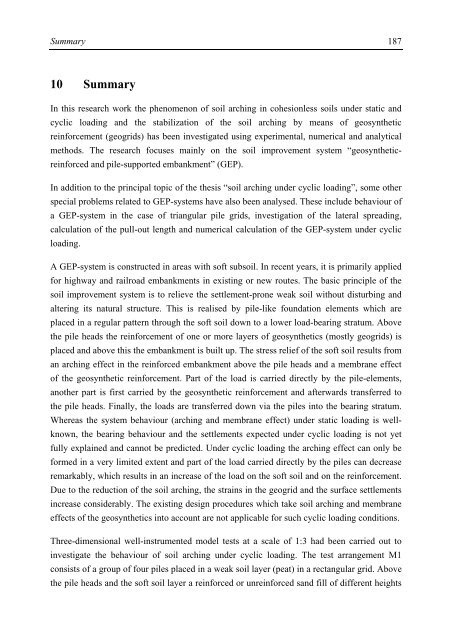Bodengewölbe unter ruhender und nichtruhender Belastung bei ...
Bodengewölbe unter ruhender und nichtruhender Belastung bei ...
Bodengewölbe unter ruhender und nichtruhender Belastung bei ...
Sie wollen auch ein ePaper? Erhöhen Sie die Reichweite Ihrer Titel.
YUMPU macht aus Druck-PDFs automatisch weboptimierte ePaper, die Google liebt.
Summary 187<br />
10 Summary<br />
In this research work the phenomenon of soil arching in cohesionless soils <strong>und</strong>er static and<br />
cyclic loading and the stabilization of the soil arching by means of geosynthetic<br />
reinforcement (geogrids) has been investigated using experimental, numerical and analytical<br />
methods. The research focuses mainly on the soil improvement system “geosyntheticreinforced<br />
and pile-supported embankment” (GEP).<br />
In addition to the principal topic of the thesis “soil arching <strong>und</strong>er cyclic loading”, some other<br />
special problems related to GEP-systems have also been analysed. These include behaviour of<br />
a GEP-system in the case of triangular pile grids, investigation of the lateral spreading,<br />
calculation of the pull-out length and numerical calculation of the GEP-system <strong>und</strong>er cyclic<br />
loading.<br />
A GEP-system is constructed in areas with soft subsoil. In recent years, it is primarily applied<br />
for highway and railroad embankments in existing or new routes. The basic principle of the<br />
soil improvement system is to relieve the settlement-prone weak soil without disturbing and<br />
altering its natural structure. This is realised by pile-like fo<strong>und</strong>ation elements which are<br />
placed in a regular pattern through the soft soil down to a lower load-bearing stratum. Above<br />
the pile heads the reinforcement of one or more layers of geosynthetics (mostly geogrids) is<br />
placed and above this the embankment is built up. The stress relief of the soft soil results from<br />
an arching effect in the reinforced embankment above the pile heads and a membrane effect<br />
of the geosynthetic reinforcement. Part of the load is carried directly by the pile-elements,<br />
another part is first carried by the geosynthetic reinforcement and afterwards transferred to<br />
the pile heads. Finally, the loads are transferred down via the piles into the bearing stratum.<br />
Whereas the system behaviour (arching and membrane effect) <strong>und</strong>er static loading is wellknown,<br />
the bearing behaviour and the settlements expected <strong>und</strong>er cyclic loading is not yet<br />
fully explained and cannot be predicted. Under cyclic loading the arching effect can only be<br />
formed in a very limited extent and part of the load carried directly by the piles can decrease<br />
remarkably, which results in an increase of the load on the soft soil and on the reinforcement.<br />
Due to the reduction of the soil arching, the strains in the geogrid and the surface settlements<br />
increase considerably. The existing design procedures which take soil arching and membrane<br />
effects of the geosynthetics into account are not applicable for such cyclic loading conditions.<br />
Three-dimensional well-instrumented model tests at a scale of 1:3 had been carried out to<br />
investigate the behaviour of soil arching <strong>und</strong>er cyclic loading. The test arrangement M1<br />
consists of a group of four piles placed in a weak soil layer (peat) in a rectangular grid. Above<br />
the pile heads and the soft soil layer a reinforced or unreinforced sand fill of different heights
















